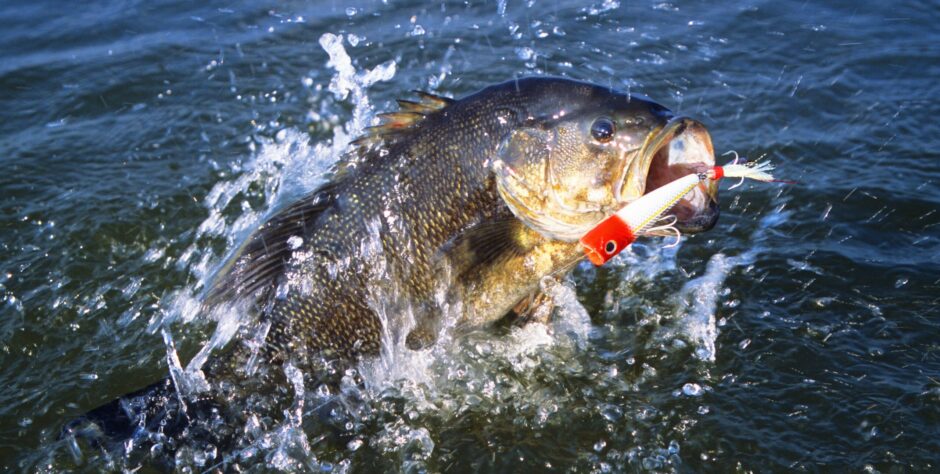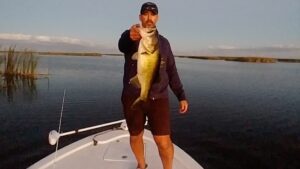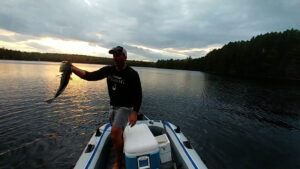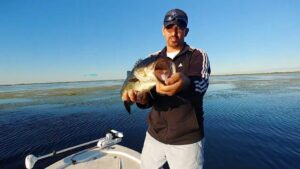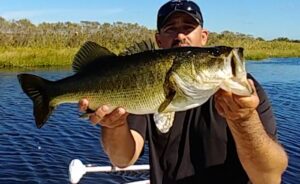Learn how to catch smallmouth bass through the seasons.
Spring
Pre-Spawn
During pre-spawn, bass are coming out of the deeper water getting ready to start their spawn. Bass will start moving to shallower water as temperatures rise above 50 degrees. As these bass transition from deeper water, you can catch them just outside of their spawning areas. A good way to find out where to catch bass during pre-spawn is to mark all the spots where the bass spawned the previous year and find the closest deep water to their spawning grounds. This is where they will most likely be in the pre-spawn phase. You should be able to find bass along points, and quick drop-offs in 8 to 12 feet of water. You can also find a lot of bass shallow cruising around looking for bait fish in the warmer water. The pre-spawn is a very good time to catch bass because they are very active.
A variety of baits and lures will work, however, during this time of year, you will hear a lot of anglers having success with jerkbaits, crankbaits, spinnerbaits and other baitfish imitating lures. That doesn’t mean the crayfish baits and worms won’t work, however, it does seem like on most bodies of water, the bite will be better with the baitfish imitations.
Spawn
Once the water reaches 55 degrees, the males start to build the nests. Actually, spawning will take place in 60 – 65 degrees of water, which is a few degrees cooler than largemouth bass. They will build their nests in 2 – 4 feet of water, however, in clear lakes, smallmouth nests can be spotted 20 feet down. When the bass are actually on the nests, they are there for one reason and this is to spawn. Bass will refuse to eat during spawning, however, there are some ways to coax them into biting your bait. They will instinctively protect their nest, so any bait that looks like a threat to their nest has a chance to get bit. Try jigs, plastic worms, buzzbaits, tubes, spinnerbaits and shallow crankbaits. Sometimes a faster lure gets a reaction strike and other times a slow-moving lure sitting in their nest will trigger a strike. Fishing with live bait can be very effective. Small minnows, night crawlers and leeches will produce during the spawn. Sometimes bass will pick up a bait and move it out of the spawning bed. If you put it right back in the bed, they might get agitated and take the whole bait. You have to be persistent to catch bass on the beds. so you can release the bass quickly.
Post Spawn
This period can be very exciting for catching large numbers of bass, however, they will be much smaller. The females head into deeper water to recover from spawning. The females tend to be inactive during this time, making it very difficult for anglers to catch some of the big females. The post-spawn period is one of the worst times of year to catch big fish, but there are usually plenty of smaller males hanging around to protect the nests. They will attack many different presentations such as jigs, spinners, grubs, crankbaits and a variety of live baits during this time of year. Fishing can be quite easy at times. Casting lures along the shorelines will produce many fish, however, most fish will be smaller males.
If you are going to look for the big females that just finished up spawning, head to the deep water hangouts near the better spawning areas. Fish slow and give these fish a chance to eat your bait because they will most likely be sluggish as they are recovering from the spawn.
Summer
Smallmouth bass fishing can definitely be hit or miss in the summer. Smallmouth bass like to roam the open water during the summer, but they will move into shallower water to feed on bait fish and crayfish. Some bass may be found suspended in open water that is 50 feet deep, which makes fishing for them incredibly difficult. While these fish will roam the open water in search of schools of bait fish, anglers will typically target their feeding areas to consistently catch fish during the summer months. You may need to fish several spots before you find a school, but once you find a school of them, you can catch several bass in a hurry. Some of the spots to key on are steep drop-offs, offshore humps, reefs, points, and deep weed lines. The hard bottom areas tend to always hold more smallmouth bass.
Fall
During the fall, smallmouth bass will school up similar to summer, but these fish tend to not move as much. The experts believe they may be conserving energy so they can fatten up for the winter. The nice thing about them staying in one place longer is that it is much easier to find them and once you do find them, you get a chance to target them with several different baits. Smallmouth bass do put the feed on during the fall. You can get away with slightly larger baits in the fall, but because they have small mouths, most anglers still use baits in the 4 to 5 inch range. As water temperatures cool below 60 degrees, smallmouth bass tend to prefer bait fish over nightcrawlers. Live baits such as minnows, chubs and small perch tend to produce much better results. When a severe cold front hits, down-size to regular fathead minnows or small shiners and you should still be able to put some fish in the boat.
Winter
The winter months are tough on smallmouth bass. These fish are not common through the ice and most of the better smallmouth bass lakes are in the northern part of the country. There are some lakes that are located in the southern part of the country that do offer some very good smallmouth bass fishing in the winter, but the fishing pattern is the same as the fall pattern up north. Smallmouth bass can be found along quick drop-offs, points, deep water humps and at times just suspended in open water. With temperatures in the 50s and low 60s, the fishing can be very good. Once water temperatures drop into the 40s, the fishing becomes very difficult and most bass anglers will not be fishing for smallmouth bass anymore. There are still some catchable fish, but you need to really downsize your baits and have some patience fishing the deeper water.
